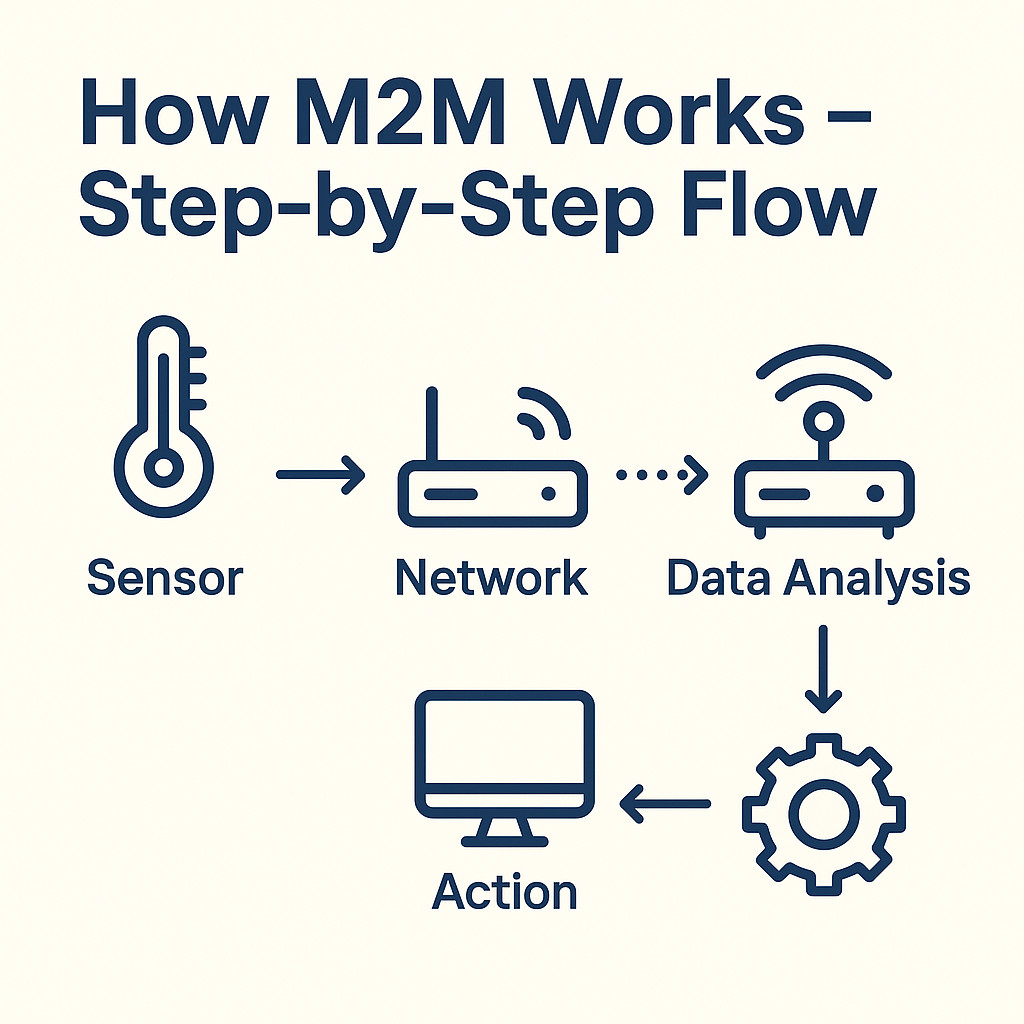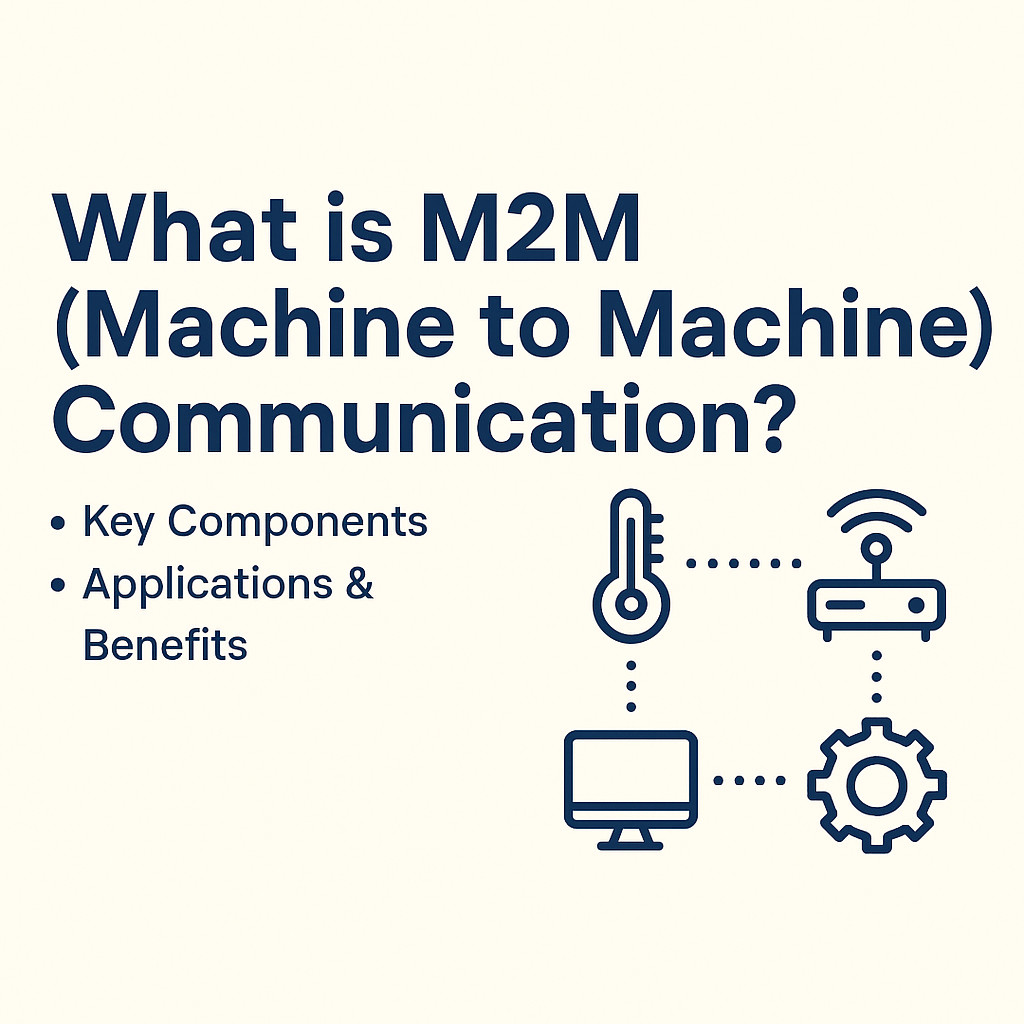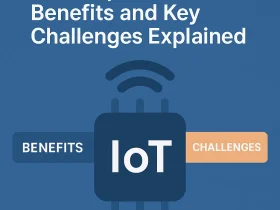What is M2M Communication?
1. Introduction to Machine to machine Communication
Imagine a world where machines talk to each other without human intervention. Your refrigerator tells the supplier it’s out of milk, or your car alerts the garage when it’s due for maintenance. This is not science fiction—it’s the reality of M2M communication, a foundational technology shaping the future of automation, smart cities, healthcare, and Industry 4.0.
2. What is M2M? – A Simple & Technical Explanation
In simple terms:
M2M stands for Machine to Machine communication, where devices or machines communicate directly with one another to perform tasks automatically.
Technically:
M2M enables networked devices—such as sensors, controllers, and machines—to exchange data over wired or wireless networks without human input. The data collected is then processed, analyzed, and acted upon, often in real time.
This kind of communication powers remote monitoring, automated systems, and intelligent decision-making, often forming the base layer of IoT (Internet of Things) deployments.
3. How M2M Works – Step-by-Step Flow

Here’s a simplified workflow:
- Data Collection: Sensors collect real-time information like temperature, pressure, speed, inventory levels, etc.
- Transmission: Data is sent through wired or wireless networks (e.g., Wi-Fi, 4G/5G, LPWAN).
- Processing: A remote server or gateway processes this data.
- Decision Making: Based on pre-programmed logic or AI, the system makes decisions.
- Action: Instructions are sent to other machines, or alerts are sent to users.
Example:
A smart vending machine tracks its stock and sends alerts to the distributor when a product is running low. It may even auto-order the item to refill itself.
4. M2M vs IoT – Are They the Same?
Though M2M and IoT often overlap, they are not the same:
| Feature | M2M | IoT |
|---|---|---|
| Focus | Device-to-device communication | Internet-based, interconnected ecosystem |
| Communication Type | Point-to-point | Network of systems |
| Connectivity | Wired/Wireless | Internet-driven (IP-based) |
| Scalability | Limited | Highly scalable |
| Use Cases | Remote monitoring, control | Smart homes, cities, wearable devices |
M2M is a subset of IoT, mainly focusing on direct communication between machines.
See details also: Difference between IoT and M2M communication (IoT vs M2M)
5. Key Components of an M2M System
A functional M2M system typically consists of:
- Sensors and Actuators
- Sensors gather data; actuators act on it (e.g., open/close valve).
- Embedded Hardware or Modules
- Microcontrollers or chips that help process information.
- Communication Network
- Technologies like Wi-Fi, Bluetooth, ZigBee, 4G/5G, LPWAN, or Ethernet.
- Middleware or Gateway
- Acts as a translator between machines and backend servers.
- Cloud/Server or Data Center
- For processing, storage, and analytics.
- Software & Dashboard
- Allows visualization and control (e.g., SCADA system).
- Autonomic Computing
- Self-managing systems that interpret data and automate actions.
6. Types of M2M Communication
M2M systems may communicate using:
- Wired Communication: Ethernet, Serial, CAN bus
- Wireless Communication: GSM, LTE, NB-IoT, LoRaWAN, Wi-Fi
- Short-range Communication: Bluetooth, ZigBee, RFID, NFC
Each type is selected based on application needs like range, bandwidth, power efficiency, and security.
7. Architecture of M2M Systems
A typical Machine to machine architecture has four layers:
- Device Layer: Sensors, actuators, embedded devices
- Network Layer: Communication protocols (IP-based or cellular)
- Middleware Layer: Gateways, data translation, aggregation
- Application Layer: User dashboards, analytics, notifications
This layered approach ensures scalability, interoperability, and ease of maintenance.
8. Applications of M2M Across Industries

M2M is widely adopted in various sectors:
Industrial Automation
- Remote control of machines
- Preventive maintenance
- Real-time production monitoring
Fleet Management & Logistics
- GPS tracking of vehicles
- Monitoring driver behavior
- Predictive maintenance alerts
Retail & Vending Machines
- Auto-restocking of inventory
- Monitoring sales and system health
- Dynamic pricing and advertising
Healthcare (Telemedicine)
- Remote patient monitoring
- Medical device alerts
- Emergency response coordination
Smart Cities
- Smart meters (gas, water, electricity)
- Traffic management systems
- Waste management automation
Agriculture
- Precision irrigation systems
- Livestock monitoring
- Weather-responsive farming
9. Benefits of M2M Communication
Implementing M2M offers several tangible advantages:
- Automation: Reduces human intervention and operational delays
- Efficiency: Machines work optimally based on real-time feedback
- Cost Savings: Predictive maintenance cuts downtime and repair costs
- Remote Management: Control systems from anywhere
- Safety: Monitor critical systems to prevent hazards
- Scalability: Easily expand as operations grow
M2M is a major driver of Industry 4.0 and digital transformation.
10. Challenges in M2M Deployment
Despite its potential, M2M faces a few hurdles:
- Security: M2M networks can be targets for cyberattacks
- Interoperability: Devices from different vendors may not communicate well
- Network Dependency: Performance relies heavily on connectivity
- Initial Costs: Setting up infrastructure can be expensive
- Data Management: Requires scalable cloud and analytics support
These are actively being addressed by newer standards and protocols.
11. Future Trends of Machine to Machine in 2025 and Beyond
In 2025, M2M communication is evolving rapidly:
- 5G Integration: Ultra-fast, low-latency communication
- AI Integration: Smarter decision-making at the edge
- Edge Computing: Real-time processing without relying on cloud
- Digital Twins: Simulate and predict machine behavior
- Green Tech: Energy-efficient M2M for sustainability goals
12. Frequently Asked Questions (FAQs)
Q1. Is M2M the same as IoT?
A: No, M2M is more about point-to-point communication, while IoT involves a broader, internet-connected ecosystem.
Q2. Where is M2M used the most?
A: It is heavily used in manufacturing, logistics, automotive, healthcare, and smart metering.
Q3. What protocols are used in M2M communication?
A: Common protocols include MQTT, CoAP, Modbus, HTTP, and LoRaWAN.
Q4. Can M2M work without the internet?
A: Yes, M2M systems can communicate over private wired/wireless networks without internet access.
13. Conclusion
Machine-to-Machine (M2M) communication has transitioned from a niche concept to a mainstream technology powering automation and smart innovations across industries. From helping manage large fleets to powering your smart home, M2M enables real-time decision-making and seamless operations—often without us noticing.
As 2025 progresses, M2M’s integration with AI, edge computing, and 5G will transform how industries manage resources, serve customers, and build smarter infrastructure.
See also: MQTT Protocol for M2M and IoT applications-Introduction
Like this article? Share your thoughts in the comments.
Start Your IoT Journey Today
🔔 Subscribe to Our YouTube Channel » for IoT video Tutorials.
🌐 Start Learning IoT Basics Now » and What is IoT? – Introduction to IoT for Beginners on IoTDunia.com!
Check out Top IoT Applications in Real World – Smart Use Cases 2025, IoT career guide 2025, Best Projects on IoT for Beginners










Leave a Review